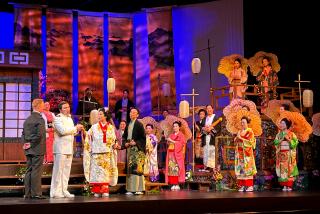UCI CONFERENCE : BEYOND ISADORA’S LEGEND
- Share via
A meteoric phenomenon in the early development of modern dance, Isadora Duncan--who died in 1927--remains a controversial figure today.
Only a few seconds of movie footage survive to show her actually dancing. For most contemporary audiences, she has become a legend interpreted by stars such as Marcia Haydee, Lynn Seymour and Maya Plisetskaya--who never saw her perform.
To help fill in the gaps, dance history scholars from the United States, Canada and Europe are convening in Orange County this weekend to share the latest research on Duncan.
Sponsored by the Society of Dance History Scholars and hosted by UC Irvine, the conference will be held today at the Irvine Hilton Hotel and Sunday on the UC Irvine campus. Sessions are open to the public, but there is a $30 daily fee for non-members.
(Lectures today will focus on Duncan’s ideas and influence, tours in Europe and use of music. On Sunday, lecture-demonstrations and workshops in Duncan technique will be held from 9 to 10:30 a.m. and from 1:45 to 4 p.m. at UCI’s dance studios.)
“I’ve been disturbed by popular films of Isadora that show her as a flamboyant figure who led an extravagant life and who thought she was an artist,” Nancy Lee Ruyter, associate dean of fine arts at UCI, said in a recent phone interview.
Ruyter had in mind Karel Reisz’s controversial 1969 movie “Isadora” starring Vanessa Redgrave (which also was released as “The Loves of Isadora”).
“Duncan was a seminal figure in the development of modern dance, certainly, most directly, but also less directly on the development of ballet,” Ruyter said.
“There are those who would say that Fokine owed all he did to Duncan. Others say, stuff and nonsense. How direct her influence was is a matter of conjecture.”
Choreographer Michel Fokine created “Firebird,” “Petrouchka,” “Le Spectre de la rose” and “Les Sylphides” for the Ballets Russes de Serge Diaghilev. These and other works set new standards in ballet for expressivity and the integration of dance, music and scenic design.
Both Duncan and Fokine, however, shared the notion that a choreographer should not “start with technique that you have to adhere to no matter what,” Ruyter said.
“You start with what you want to express, then organize and refine it in terms of movement.”
Obviously, one of the problems in answering questions about Duncan results from our being three generations removed from her.
But there are living links, Ruyter said.
“Isadora ‘adopted’ six young women around the First World War,” she said. “She taught and trained them and presented them in concerts. Out of those six, only three kept on until they died--but some lived until the 1970s.” They in turn trained other dancers, she said.
“We’ll have people at the conference who have studied with one or another or with more than one of the original six. So we’ll have the second generation of Duncan dancers.”
One dancer who studied with a disciple of Duncan is Lori Belilove. Belilove will dance reconstructions of Duncan’s “Mazurka,” “Three Etudes,” “Mother” and “Revolutionary” on programs by the UCI Dance Ensemble at 2 and 8 p.m. today in the Fine Arts Village Theatre on campus.
Other second-generation “Isadorables” (as the original six were known) will meet for a panel discussion at 10:45 a.m. on Sunday in Dance Studio 128.
“We’ll show them a videotape of a reconstruction of a Duncan dance and get their reactions in terms of how authentic it is, what they would do differently or how they would evaluate it,” Ruyter said.
Ruyter agreed that even if the works can be accurately reconstructed, controversy is not over. The next question is whether any of these works can have expressive meaning for a modern audience.
“Well, that raises the question:Does a Baroque work or a Renaissance dance--or ‘Giselle’ or anything from the past--have value for us, or is it a museum piece, dead, without current meaning?” Ruyter said.
“If done well, ‘Giselle’ still moves enough of us to be worth doing. And some people are thrilled and delighted with Baroque and Renaissance dance.
“I don’t know about the Duncan material because I haven’t seen any reconstructions. It probably really depends on who’s doing it. I’m eagerly awaiting answers to these questions.”
r
More to Read
The biggest entertainment stories
Get our big stories about Hollywood, film, television, music, arts, culture and more right in your inbox as soon as they publish.
You may occasionally receive promotional content from the Los Angeles Times.










